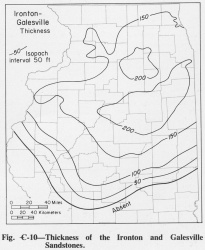Galesville Sandstone
Lithostratigraphy: Knox Dolomite Megagroup >>Galesville Sandstone
Chronostratigraphy: Paleozoic Erathem >>Cambrian System >>Croixan Series >>Dresbachian Stage
Allostratigraphy: Sauk Sequence
Primary source
Willman, H. B., Elwood Atherton, T. C. Buschbach, Charles Collinson, John C. Frye, M. E. Hopkins, Jerry A. Lineback, and Jack A. Simon, 1975, Handbook of Illinois Stratigraphy: Illinois State Geological Survey Bulletin 95, 261 p.
Contributing author(s)
T. C. Buschbach
Name
Original description
Galesville Sandstone (Trowbridge and Atwater, 1934, p. 43).
Derivation
Named for Galesville, Trempealeau County, Wisconsin.
Other names
History/background
In earlier reports Galesville and Ironton Sandstones were called the Dresbach Sandstone.
Type section
Type location
The type section of the Galesville Sandstone is in an exposure on Beaver Creek near Galesville, Trempealeau County, Wisconsin. The section exposes poorly sorted, fossiliferous sandstone of the Ironton Formation overlying 88 feet of the Galesville Sandstone, which in turn lies on fossiliferous sandstoneand shale of the Eau Claire Formation.
Type author(s)
Type status
Reference section
Reference location
Reference author(s)
Reference status
Stratigraphic relationships
Extent and thickness
The Galesville occurs throughout the northern half of Illinois but is not exposed. It is commonly 40-100 feet thick. At its southern margin, the Galesville grades laterally through a zone of dolomitic sandstone about 50 miles wide to nonsandy dolomite of the Knox Megagroup.
Lithology
In many borings in Illinois the Galesville is not easily distinguished from the overlying Ironton Sandstone, and their combined thickness is shown in figure Є-10. The name "Galesville" is applied as far south as the sandy zone can be identified, at which place the formation is terminated by vertical cut-off. The Galesville Sandstone consists of white to light buff, clean to locally silty, fine-grained, moderately well sorted, friable, and generally nondolomitic sandstone (Buschbach, 1964). Locally, light buff to pink dolomite is a cementing material. The Galesville and the overlying Ironton Sandstone form an important aquifer in northern Illinois.
Core(s)
Photograph(s)
Contacts
The Galesville appears to be conformable with both the overlying and underlying formations.
Well log characteristics
Fossils
Age and correlation
The Galesville Sandstone is also recognized in Iowa, Minnesota, Michigan, and Indiana. It is not traced directly to the Missouri outcrop region, but it probably is equivalent to the upper carbonate beds of the Bonneterre Formation.
Environments of deposition
From a petrographic study and analysis of sedimentary structures, Emrich (1966) concluded that the Galesville and Ironton Sandstones were derived from pre-existing sedimentary rocks north of Illinois and were deposited on a broad, shallow shelf.
Economic importance
Remarks
References
BUSCHBACH, T. C., 1964, Cambrian and Ordovician strata of northeastern Illinois: Illinois State Geological Survey Report of Investigations 218, 90 p.
EMRICH, G. H., 1966, Ironton and Galesville (Cambrian) Sandstones in Illinois and adjacent areas: Illinois State Geological Survey Circular 403, 55 p.
TROWBRIDGE, A. C., and G. I. ATWATER, 1934, Stratigraphic problems in the upper Mississippi Valley: Geological Society of America Bulletin, v. 45, p. 21-80.
ISGS Codes
| Stratigraphic Code | Geo Unit Designation |
|---|---|
